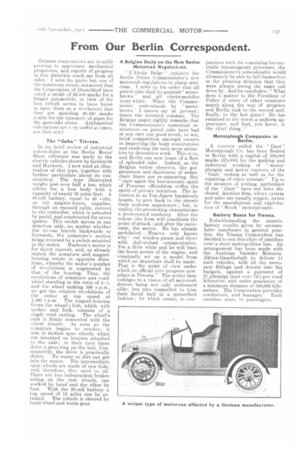From Our Berlin Correspondent.
Page 19

If you've noticed an error in this article please click here to report it so we can fix it.
German corporations are steadily growing to appreciate mechanical propulsion, and reports of progress in this direction reach me from all sides. I note (to quote but one of the numerous recent instances) that the Corporation of Dusseldorf have voted a credit of 22,500 marks for a freight automobile, in view of the fact (which seems to have burst in upon them as a revelation) that they are spending 28,460 marks yearly for the transport of pipes for the gasworks alone. Arithmetical ealcalations are v.q.y useful at times, are they not
The " Geha " Tr-van.
In my brief review of industrial automobiles at the Berlin Motor Show reference was made to the electric vehicles shown by Gebhardt and Harhorn, I now send an illustration of this type, together with further particulars about its construction. The type illustrated weighs just over half a ton, which allows for a box body with a capacity of nearly 36 cubic feet. A 20-cell battery, equal to 40 volts, at 150 ampere-hours, supplies, through an encased cable, current to the controller, which is actuated by pedal, and constructed for seven speeds. This switch moves in one direction only, no matter whether the tri-van travels backwards or forwards, the armature's motion being reversed by a switch mounted in the motor. Harhorn's motor is for direct current, and, as already stated, the armature and magnethousing rotate in opposite directions, whereby the motor's number of revolutions is augmented by that of the housing. Thus, the revolutions of armature and roadwheel standing in the ratio of 5 :1, and the wheel making 300 r.p.m., we get the relative revolutions of the motor at top speed at 1,500 isp.m. The magnet-housing forms the wheel's hub, which, with spokes and fork, consists of a single steel casting. The wheel's axle is firmly connected with the wheel bearer. As soon as the armature begins to revolve, it sets in motion spur wheels, which are mounted on bearers attached to the axle ; in their turn these drive a gear-ring on the hub. Consequently, the drive is practically direct. No water or dirt can get into the motor. The intermediate spur wheels are made of raw hide, and, therefore, they need no oil. There are two independent brakes acting on the rear wheels, one worked by hand and the other by foot. With the 20-cell battery a top speed of 12 miles can be at tained, The vehicle is steered by hand-wheel and worm-gear. A Belgian Daily on the New Berlin Motorcab R e gulat icas.
" L'Etoile Beige " subjects the Berlin Police Commissioner's new motoreab regulations to sharp criticism. I refer to his order that all petrol cabs shall be painted " mewsbrown " and all electromobiles ivory-white. What the Commissioner understands by " mews-brown " I cannot. say at present ; hence the inverted commas. The Belgian paper rightly remarks that the Commissioner's numerical restrictions on petrol cabs have had at any rate one good result, to wit, brisk competition amongst owners in improving the body construction and rendering the cabs more attractive by decorative work. This is so, and Berlin can now boast of a fleet of splendid cabs. Indeed, as the Belgian writer observes, the gorgeousness and daintiness of sedanchair times are re-appearing. But "once again the bureaucratic spirit of Prussian officialdom stifles the spirit of private initiation. The intention is, as Von Jagow harmlessly boasts, to give back to the streets their uniform appearance ; but, in reality, the proceeding characterizes a pronounced tendency. After the colour, the form will constitute the point of attack ; and after the carosBerle, the motor. He has already prohibited —• Heaven only knows why! --cut window-panes and those with dull-etched ornamentation. Yet. a little while and he will limit the horse-power of the engine, and eventually set up a model from which no departure shall be made. That is the point of view under which an official eyes progress nowadays in Prussia." The writer then indulges in a vision of all motorcab drivers being not only uniformed alike, but also compelled to trim their facial hair in a prescribed fashion ; by which means, in eon junction with the remaining bureaucratic intransigeant processes, the Commissioner's subordinates would ultimately be able to lull themselves in the pleasing delusion that they were always seeing the same cab drive by. And he concludes: "What does it matter to the President of Police if cities of other countries march along the way of progress and Berlin sink to the second and, finally, to the last place? He has returned to the street a uniform appearance, and that you know, is the chief thing
Motorplough Companies in Berlin.
A concern called the " Gast" Motorplough Co. has been floated in Berlin with a capital of 100,000 marks (£5,000) for the making and industrial working of " motorploughs and motor tractors of the '
Cast' system as well as for the repairing of other systems." Up to the moment, of writing, particulars of the " Gast " have not been disclosed. Another firm, whose system and sales are equally cryptic, exists for the manufacture and exploitation of " Stock " motorploughs.
Battery Buses for Vienna.
Notwithstanding the unsatisfactory results given by accumulator omnibuses in general practice, the Vienna Corporation has decided to run this class of omnibus over a short. metropolitan line. An arrangement has been made with the Austrian Daimler MotorenAktien-Gesellschaft to deliver 11 such vehicles, with all the necessary fittings and drivers into the bargain, against a payment. of 57 pfennigs (just over 7d.) per road kilometre, and under guarantee of a minimum distance of 380,000 kilometres. The Corporation provides conductors, and manages. Each omnibus seats 18 passengers.
























